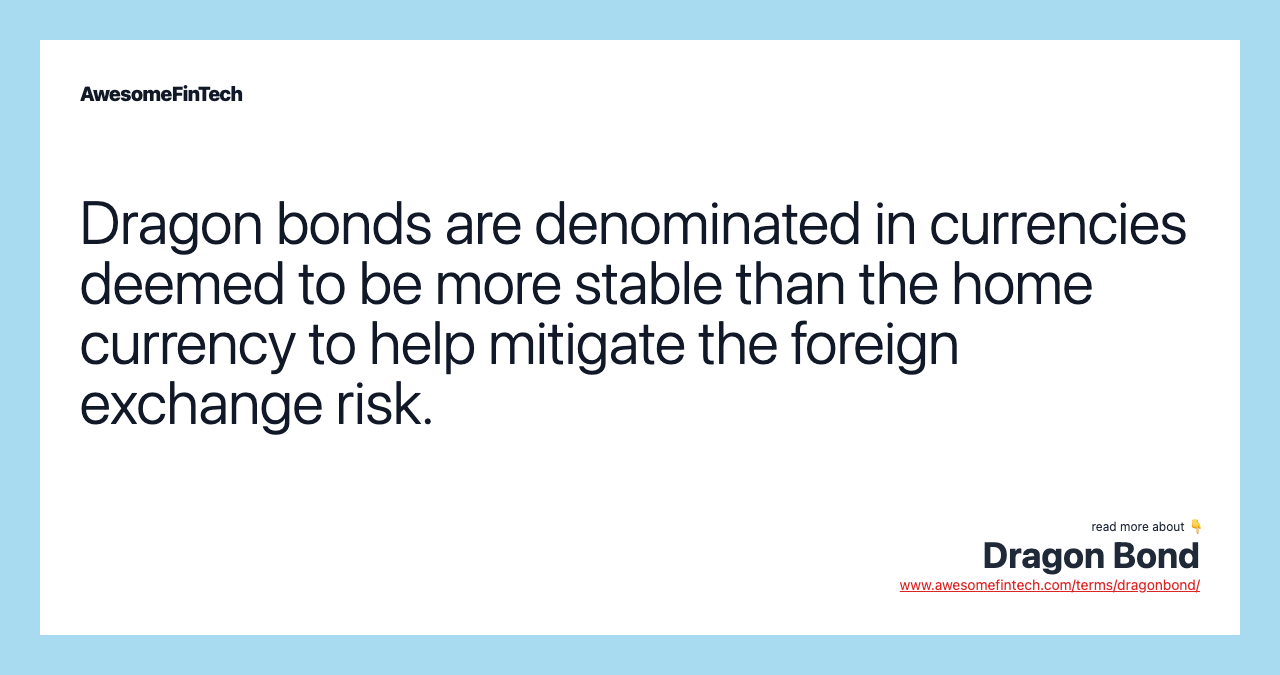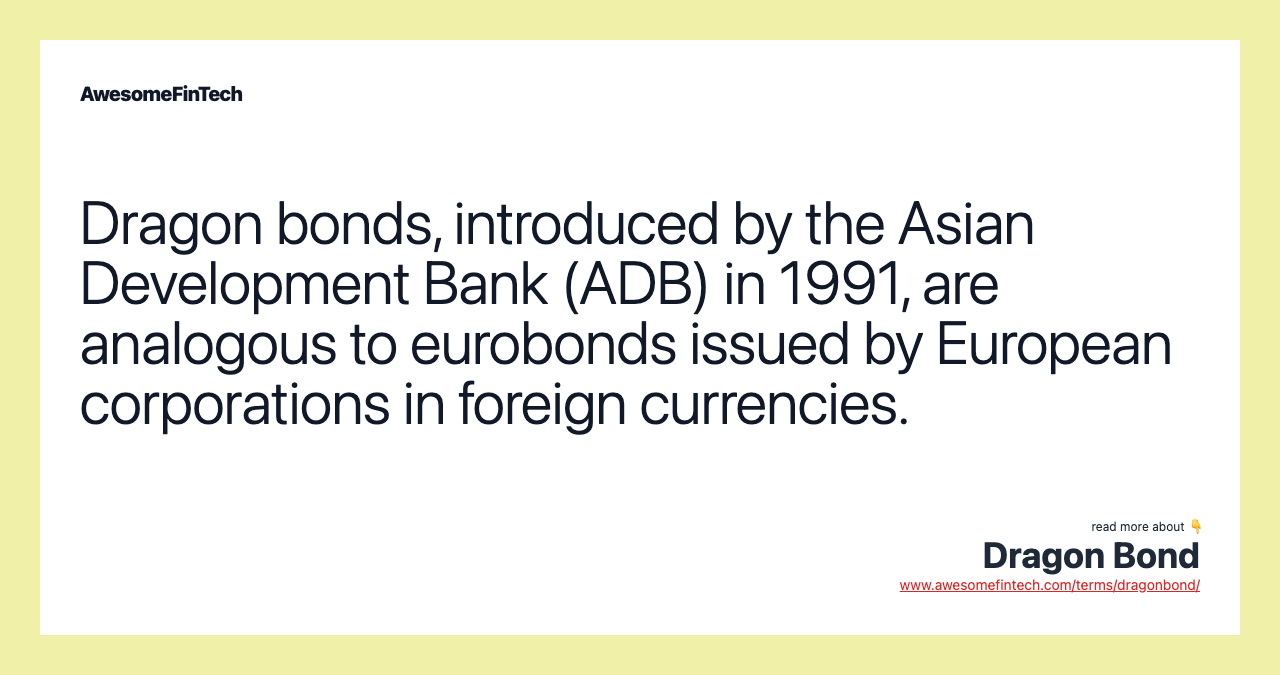Dragon Bond
A dragon bond is a long-term debt security issued by firms operating in Asian nations (excluding Japan), but denominated in foreign, stable currencies, such as the U.S. dollar (USD) or the Japanese yen (JPY). A dragon bond is a long-term debt security issued by firms operating in Asian nations (excluding Japan), but denominated in foreign, stable currencies, such as the U.S. dollar (USD) or the Japanese yen (JPY). Dragon bonds are denominated in currencies deemed to be more stable than the home currency to help mitigate the foreign exchange risk. A dragon bond is a fixed-income security denominated in currencies deemed more stable than the home currency; it is seen as more attractive to foreign investors as a result. Dragon bonds are Asian corporate bonds, ex-Japan, but denominated in a foreign currency.

What Is a Dragon Bond?
A dragon bond is a long-term debt security issued by firms operating in Asian nations (excluding Japan), but denominated in foreign, stable currencies, such as the U.S. dollar (USD) or the Japanese yen (JPY).



Understanding Dragon Bonds
A dragon bond is a fixed-income security denominated in currencies deemed more stable than the home currency; it is seen as more attractive to foreign investors as a result. The rationale for structuring them to be as appealing as possible to investors outside of Asia is because they mitigate the foreign exchange risk that can impact returns as currency values fluctuate. Dragon bonds are similar to eurobonds in that they are denominated in foreign currencies that are liquid and stable, but in the Asian context instead of Europe.
Dragon bonds were first introduced in 1991 by the Asian Development Bank (ADB). Because of the foreign denomination, these can be more complex than other bonds because of international differences in taxation, regulatory compliance issues facing firms that issue them, plus limited liquidity in trading them in secondary markets.
Dragon Bonds and Currency Risk
Dragon bonds were created to broaden the market for fixed-income securities in Asia and develop more active Asian financial markets. Although Asian companies had issued bonds in local currencies, they appealed mostly to domestic investors limiting access to capital. Foreign investors were often reluctant to buy bonds dominated in currencies that could fluctuate rapidly. Currencies such as the U.S. dollar and Japanese yen were considered stable enough for accumulating assets.
For example, an Indonesian company might issue a 20-year bond denominated in Indonesian rupiah (IDR), with a coupon rate of 4-percent paid annually. If the U.S. dollar-Indonesian rupiah (USD/IDR) were 10,000 rupiahs per one U.S. dollar, then a 100-million rupiah bond would be the equivalent of $10,000. Each interest payment of 4 million rupiah would represent $400 at the time the bond is issued.
To an Indonesian investor, an investment of 100 million rupiah would pay 4 million rupiah per year with return of principal after 20 years. But for an investor buying such a bond with U.S. dollars, an unfavorable movement between the relative value of the two currencies could create extra risk.
If in the next year the exchange rate shifted from 10,000 IDR/1 USD to 11,000 IDR/1 USD, then the first coupon payment of 4 million rupiah would only be worth only about $364 instead of $400 as anticipated when the bond was first issued. The bond's 100-million rupiah face value would be worth about $9,091. And if the prevailing interest rate moves up, the value of the bond would be even lower.
However, a dragon bond denominated in USD, while still subject to interest rate risk, would not be subject to currency risk. The regional economy has changed significantly in the years since the introduction of dragon bonds in 1991, including the 1997 Asian financial crisis, and the growth of the Chinese economy. However, dragon bonds continue to help Asian markets attract more foreign investment.
Related terms:
Asian Development Bank
Founded in 1966, the Asian Development Bank's headquarters are in Manila, Philippines. Its primary mission is to foster growth and cooperation in the region. read more
Asian Financial Crisis
The Asian financial crisis was a series of currency devaluations and other events that spread through many Asian markets beginning in the summer of 1997. read more
Coupon Rate
A coupon rate is the yield paid by a fixed income security, which is the annual coupon payments divided by the bond's face or par value. read more
Dollar Bond
A dollar bond is a U.S. denominated bond that trades outside of the U.S. and both the principal and any coupon payments are paid in U.S. dollars. read more
Eurobond
A Eurobond is a bond issued in a currency other than the currency of the country or market in which it is issued. read more
What Is a Eurodollar Bond?
Eurodollar bonds are important funding sources for international entities, denominated in U.S. dollars but issued and held overseas. read more
Fixed-Income Security
A fixed-income security is an investment providing a level stream of interest income over a period of time. read more
Fixed Income & Examples
Fixed income refers to assets and securities that bear fixed cash flows for investors, such as fixed rate interest or dividends. read more
Foreign Exchange Risk
Foreign exchange risk refers to the losses that an international financial transaction may incur due to currency fluctuations. read more
Indonesian Rupiah (IDR)
The Indonesian rupiah (IDR) is the currency of Indonesia, and IDR is the unique currency code assigned to it in the global foreign exchange market. read more